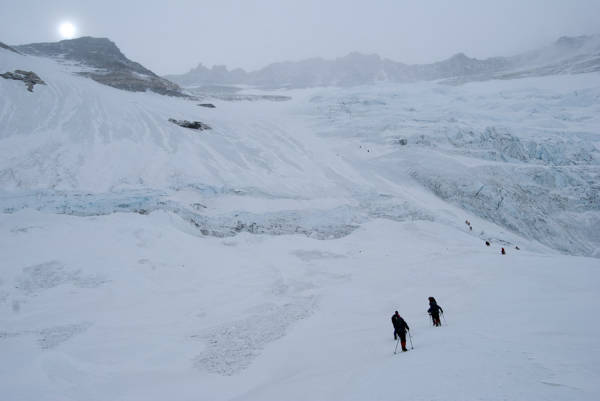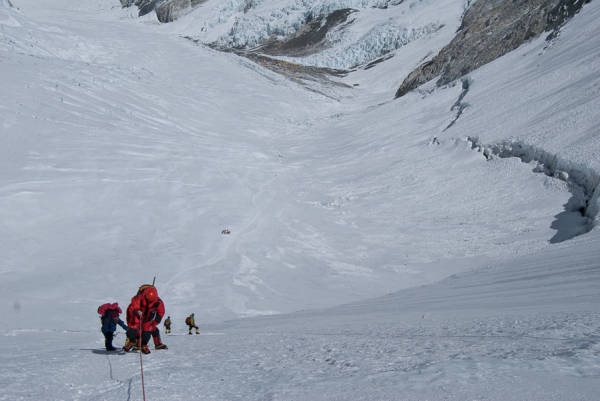In the spring of 2013 there was a well-publicized incident between Western climbers and Sherpas on the slopes of Mount Everest. Here are some links to the many new stories on this incident:
Alan Arnette (and read the links inside)
Rather than discuss the individuals involved and judge their actions, I want talk more generally about why such incidents occur (specifically the initial incident that sparked the more salacious events afterwards). If the issues were confined only to Mount Everest it frankly wouldn’t be all that important. But tactics used on Everest are spreading to other high peaks and other countries, so this problem will arise again. And the lessons of this incident can be applied in other situations.
You can’t understand the problem unless you understand the system on Everest and the parties involved. If you already do, skip ahead.
How it all works
On the standard routes on Mount Everest there are three groups of people: climbers, guides/companies, and staff. For over 20 years, the climbers on Everest have fallen into two groups: the vast majority are tourists with little or no mountaineering background and a small number are experienced climbers who are capable of climbing the mountain without guidance.
Climbing the normal routes on Everest goes like this:
1. Tourists pay tens of thousands of dollars to a guide/company.
2. The guide/company hires sherpas to do the manual labor and work with tourists.
3. The companies pool their equipment and manpower.
4. Sherpas install ropes all the way up the mountain and establish intermediate camps.
5. Guides, sherpas, and tourists ascend the ropes to the summit and back.
Tourists get their summits, guides and sherpas get their money and build a reputation.
There are three main actors in this drama: The high-altitude porters (sherpas), the elite climbers (Rockstars), and the guiding companies (who cater to tourists).
Sherpas
The sherpa stereotype is the happy, smiling, hard-working, high-altitude load carrier. In reality sherpas are no different than any other group of people – some are jovial, some are quiet, some are aggressive, and there are some real jerks. Note: since many high-altitude porters are not of Sherpa ethnic heritage I use the lower case ‘sherpa’ throughout.
As indigenous highlanders, sherpas have adapted to the thin air and they generally perform better than lowlanders at altitude. They have also adapted to the huge influx of hard currency brought about by the Disney-fication of Everest. Everest is the place where sherpas make the big money. They are rewarded based on performance: how high they go, how many loads they carry, and how much they please their clients. Their money comes from the tourists. A successful high-altitude sherpa can become a trekking leader and have a long career away from the hazards of mountaineering.
Sherpas work very hard in dangerous conditions. They all have friends and relatives who died in the mountains. A growing number are well-trained climbers who do not need a Western climber to make decisions for them (as happened in the old days).
European Rockstars
European climbers practice their craft in a very crowded and ‘urban’ environment. The Alps are filled with cable cars, huts, and humans; they are totally unlike our North American mountains. Speed is safety in the mountains, and European climbers are accustomed to doing whatever they must to climb past the ever-present slower parties.
The crowds mean that your typical European climber will act more like he is on a crowded city street than on a mountain — he will hike or climb past you without even a look. And he probably won’t move out of your way on the trail or mountain. The most vivid example of this behavior that I’ve seen was in Pakistan, where two Italians wearing only Speedos walked down the trail side-by-side and forced porters carrying 50 pounds loads to detour around them.
The elite climber in Europe is treated like a rock star and will be a household name. These elite climbers are well known because they succeed on previously unclimbed routes (which by definition are not crowded).
Rockstars travel with a retinue of photographers, videographers, and Internet technicians to deliver gripping media coverage to the public. This same public seldom questions how the cameraman got above the Rockstar to photograph him boldly climbing up that ‘unclimbed’ route…but I digress.
It is important to note that the Rockstars in this case were not planning on climbing the normal climbing route, but they were climbing parts of it to acclimatize to low oxygen levels.
Guiding Companies
The companies who take tourists up Everest have one goal — to make money. This requires maximizing summit success and minimizing injury and death. Primarily of clients, as they get the most press. The best way to do this is to keep clients off of the mountain as much as possible. Much of the acclimatization needed to physiologically adjust to altitude can be done at base camp, and some companies are only having their clients sleep on the mountain for a few nights before attempting the summit.
The other method is to remove as many of the climbing obstacles as possible. This means installing a continuous ribbon of rope from bottom to top of Everest. On crowded mountains there may be two sets of ropes, one for ascent and one for descent. On Everest all of the work installing ropes is done by sherpas.
The companies also know that they will be called upon to aid any person in need on the mountain and they are the ones with the manpower to do it. I’m Exhibit A for that unwritten rule!
Hypoxia
Lack of oxygen affects people in different ways. Neither climbers nor sherpas had climbed so high on Everest in this case, so they were probably all affected to some degree. Severe fatigue is the norm; mood swings and decision-making difficulty go hand in hand with fatigue.
To acclimatize to the reduced oxygen levels it is normal to move up and down the mountain to gradually expose the body to the thin air. At the altitudes involved here (about 7000 meters or 23,000 feet) bottled oxygen is not normally used.
The Situation
- The sherpas were burdened with extra ropes and equipment that was needed to install the lines of fixed ropes up the Lhotse Face.
- The Rockstars were on an acclimatization trip, climbing unroped on somewhat steep ground, and a single mistake would have led to death.
- Climbing below another person means you are exposed to falling ice which is dislodged by the upper climber.
I’m not going to rehash the incident on the mountain; you can read the ‘he said, she said’ drama elsewhere.
Causes of the Initial Incident
The sherpas’ (and guide /companies’) viewpoint was that the sherpas’ job was to climb the mountain and fixed the ropes. This had been agreed to by all of the companies and it is traditional (but only on Everest) that no other climbers interfere with this process.
The Rockstar viewpoint was that climbing below, alongside, and above other climbers is normal and that their superior skill and conditioning would prevent mishaps that might occur to less skilled climbers.
Mix in the mind-altering effects of altitude and fatigue and you have a Confrontation. Both sides were perplexed because each group’s actions (on the mountain) were entirely consistent with their normal approach to climbing, and each could not understand why the other group would behave so inappropriately (from each group’s perspective).
The Larger Picture
As a climber I find the transformation of Everest into a high-priced thrill ride quite appalling. Unfortunately the tactics are spreading to other high peaks (notably K2), where sherpa teams are brought in to pave the way to the top for under- or un-experienced ‘climbers.’
While on Everest I would have happily carried some token loads to help with the rope fixing process, but I realized that the best thing to do was to let the sherpas earn their money – my help would not be appreciated. I think that Western climbers must realize that the normal routes on Everest have a very different set of rules to play by. The Rockstars in this case did not understand that distinction.
Most climbing sherpas have a very narrow viewpoint of what ‘climbing’ is. The are primarily exposed to tourists on Everest, Cho Oyo, and Shishapangma (the three easier 8000 meter peaks) and seldom spend any time consorting with qualified climbers. The sherpas need to realize that they must coexist with real climbers and that the rules on other mountains are not necessarily those of Everest.
The companies need to realize that the independent climbers on Everest (not just the Rockstars) may need some special attention and guidance concerning the unwritten rules of Everest because these rules are unique. If the independent climber fails to heed this advice, then frontier justice will prevail on the mountain – just like it always has.
My $0.02 concerning this incident (as it has been reported)
- The Rockstars had no need to climb on that day. They should have retreated.
- The behavior of some sherpas at Camp 2 (threatening the Rockstars with death and injury) was inexcusable.
- The Company leaders and guides were equally at fault for not keeping their employees under control. The ringleaders of the sherpa violence should have been dismissed immediately.
- Instant media led to the incident being overblown and exploited.
If you have any comments, please email me (address above) and I’ll be glad to address substantive comments in the blog.

